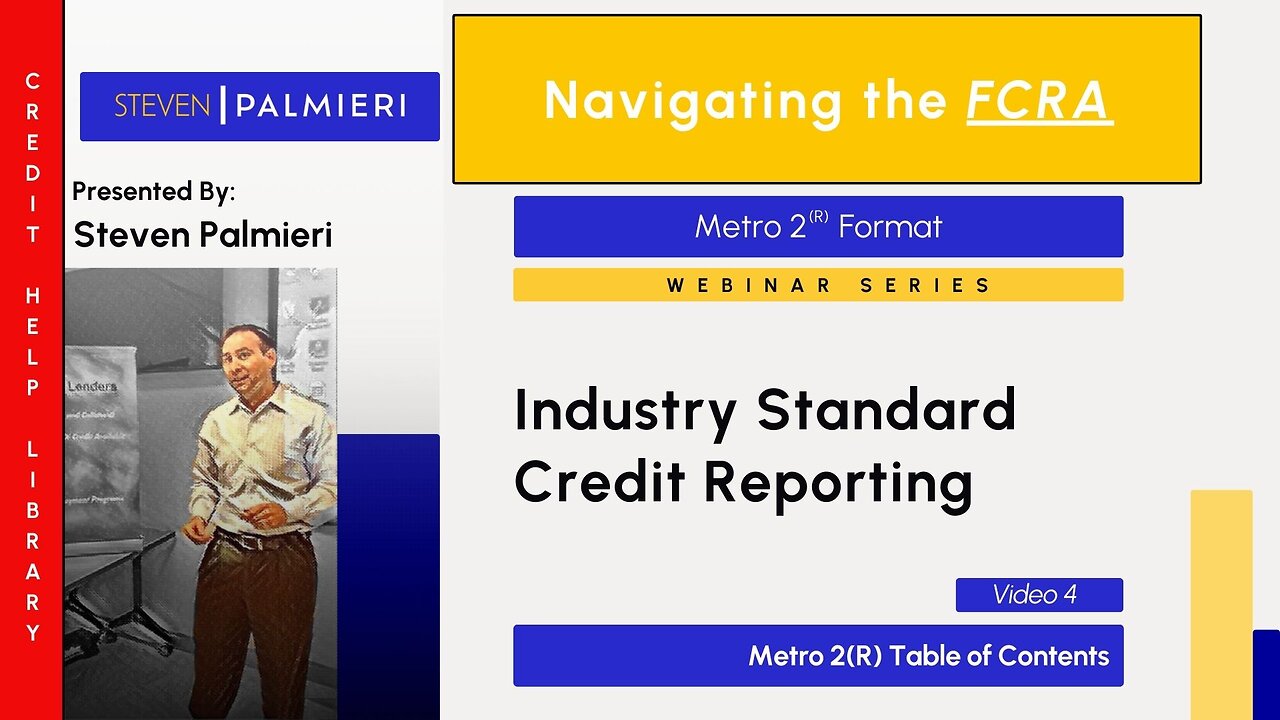Premium Only Content

Metro 2 Table of Contents
The video introduces the Metro 2 industry standard, as outlined in the 2020 Credit Reporting Resource Guide (CRRG) published by the Consumer Data Industry Association (CDIA), and explains its structure to help viewers use it for accurately reading credit reports, identifying errors, and crafting dispute letters to consumer reporting agencies (CRAs). Metro 2 is critical because it aligns with the FCRA’s requirement for reasonable procedures to ensure maximum possible accuracy, providing a standardized format that credit bureaus and furnishers follow.
The CRRG’s table of contents breaks down Metro 2 into key sections. Chapter 1 outlines the roles of involved parties (e.g., CDIA, credit bureaus, furnishers, regulators like the CFPB and FTC). Chapter 2 explains the importance of Metro 2 as an industry standard for automated data reporting. Chapter 3 details the Metro 2 format, organizing data into segments like a book with chapters: the base segment (primary consumer data), J1/J2 segments (associated consumers), K1-K4 segments (creditor and payment details), L1 (account changes), N1 (employment), and header/trailer records (file transfer data). Chapter 4 provides field definitions, listing how each segment’s data fields should be reported, which is essential for spotting inconsistencies across reports from different bureaus. Chapter 5 offers exhibits with valid data options, Chapter 6 addresses FAQs (e.g., reporting repossessions or charge-offs), and Chapter 7 is a glossary. Chapters 8-13 cover implementation checklists and specific guidelines (e.g., child support, student loans, mortgages), while Chapter 14 details the E-OSCAR dispute system.
For readers, Metro 2’s structure—especially Chapters 3 and 4—enables a precise analysis of credit report data against the standard. By comparing reported fields (e.g., payment history, creditor info) to Metro 2 specifications, users can identify errors and reference these discrepancies in dispute letters, leveraging the bureaus’ own standard to demand corrections. The FAQ and examples in later chapters further clarify complex scenarios, enhancing dispute effectiveness.
-
 LIVE
LIVE
SpartakusLIVE
52 minutes ago#1 Pilgrim of PAIN Gives Thanks HAPPILY as he DESTROYS Enemies and BAGS LOOT
4,911 watching -
 DVR
DVR
iCkEdMeL
1 hour agoBREAKING: National Guard Soldier Dies + New Video Shows Suspect Opening Fire
823 -
 25:43
25:43
Russell Brand
1 day agoThis Is Getting Out Of Hand
93.8K82 -
 LIVE
LIVE
The Quartering
9 hours agoThanksgiving Day Yule Log!
2,723 watching -
 LIVE
LIVE
PandaSub2000
9 hours agoLIVE 6:30pm ET | NINTENDO PLATFORMERS Thanksgiving Special
268 watching -
 1:03:06
1:03:06
MetatronGaming
22 hours agoThis is the scariest game ever (for an Italian)
3.92K1 -
 1:09:35
1:09:35
The White House
3 hours agoPresident Trump Participates in a Call with Service Members
15.6K34 -
 LIVE
LIVE
a12cat34dog
2 hours agoHAPPY THANKSGIVING - I APPRECIATE YOU ALL SO MUCH {18+}
111 watching -
 24:55
24:55
Jasmin Laine
1 day agoCarney BRAGS About ‘Investment’—Poilievre Drops a FACT That Stops the Room
12.9K18 -
 LIVE
LIVE
SIM_N_SHIFT GAMING
1 hour agoGRAND THEFT AUTO WITH FRIENDS
50 watching